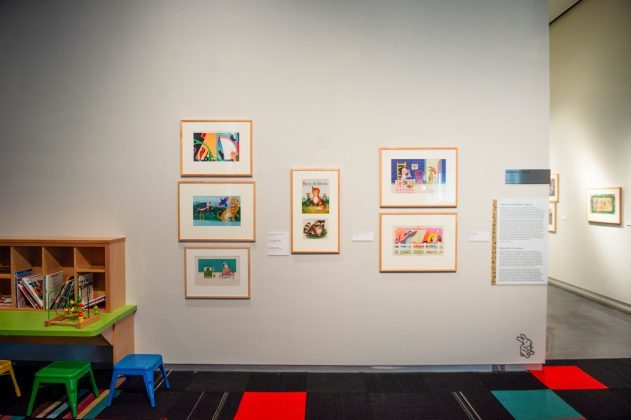Have you ever rummaged around in a family attic or flipped through a crate of old books at a yard sale—only to be stopped cold by the glint of a gold foil spine? Just like that, you’re eight years old again, tucked into bed and drifting off to tales of puppies, brave little engines, and adventurous bunnies.
That’s exactly how we felt walking into the Golden Legacy: Original Art from 80 Years of Golden Books exhibition at the LSU Museum of Art. This traveling exhibition, organized by the National Center for Children’s Illustrated Literature in Abilene, Texas, brings together original illustrations from the beloved Little Golden Books series. While the exhibition has made stops across the country, experiencing it within the familiar halls of LSU MOA added a special, personal touch to our visit.
What we found wasn’t just nostalgia—it was a celebration of art, storytelling, and the illustrations that shaped entire childhoods.
What started in 1942 as a simple idea—to make illustrated books affordable—turned into a cultural phenomenon. At just 25 cents apiece, Little Golden Books were sold everywhere from grocery store checkouts to bookstores across the country. They brought timeless stories and, more importantly, art into the homes of children coast to coast.
Artists like Garth Williams (The Rabbits’ Wedding), Eloise Wilkin (Baby Dear), Richard Scarry (Cars and Trucks and Things That Go), and Mary Blair (I Can Fly) poured their considerable talent into these small pages, changing the way we think about illustration in children’s publishing.
Stepping into the exhibition felt like flipping through the visual history of America. Original illustrations—delicate brushstrokes, bright watercolors, dynamic compositions—hung proudly on the gallery walls. Each one stood not as background for a bedtime story, but as its own complete work of art.
Art that Grows Up With Us

Original Golden Book illustrations on view at LSU Museum of Art’s Golden Legacy exhibition.
Photo courtesy of LSU Museum of Art.
Beyond nostalgia, the exhibition traced how Little Golden Books reflected the values and cultural shifts of America itself. Early stories, shaped by the hopeful conservatism of the 1940s and ’50s, emphasized obedience, family structure, and patriotism—postwar ideals meant to reassure and stabilize.
But as the country changed, so did the stories. The civil rights era, youth movements, and growing awareness of environmental and social issues began to reshape the content. Little Golden Books responded with new themes: inclusion, curiosity, and independent thought. The illustrations evolved too, trading in soft realism for bold modernism—mirroring a society slowly letting go of rigid rules in favor of color, character, and complexity.
Organized by the National Center for Children’s Illustrated Literature in Abilene, Texas, the exhibition gave these illustrations space to breathe, to be seen not just as childhood mementos but as significant visual culture. For many of us, these were the first pieces of art we ever loved.
Curating Collective Memory
One of the most striking things about Golden Legacy was its sense of care. This wasn’t just a lineup of pretty images—it was a thoughtful reflection on how memory and meaning are built over time. The show posed some honest, smart questions: How do we honor work made for mass audiences? What does it mean to frame children’s art in a museum context? And why do these images still mean so much, even decades later?

A gallery view from Golden Legacy at LSU Museum of Art, where childhood favorites meet thoughtful curatorial care.
Photo courtesy of LSU Museum of Art.
By placing the illustrations in a gallery setting, contextualized with care and history, the exhibition reminded us just how deep the roots of cultural memory go—and how illustration, even when originally meant for little hands, can tell some of the biggest stories.
What’s Next at LSU Museum of Art?
Though Golden Legacy has wrapped, LSU Museum of Art continues to explore storytelling and design in its upcoming programming. Opening June 12, Carved & Crafted: The Art of Letterpress will celebrate the tactile beauty of printmaking and typography. Then, starting September 4, the museum turns its attention to Louisiana’s creative communities with A Bayou State of Mind, an exhibition that reflects the region’s cultural richness and natural diversity.
LSU MOA continues to prove that great storytelling doesn’t end with childhood—and neither does great art. Keep your eyes open and your imagination ready. The story’s just getting good.
